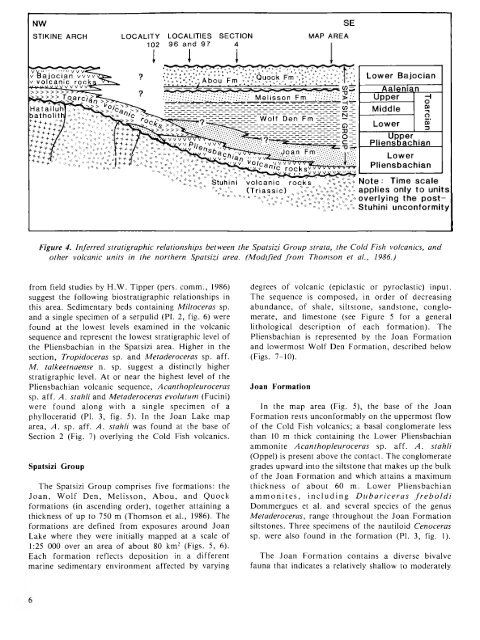PLIENSBACHIAN (LOWER JURASSIC) BIOSTRATIGRAPHY AND ...
PLIENSBACHIAN (LOWER JURASSIC) BIOSTRATIGRAPHY AND ...
PLIENSBACHIAN (LOWER JURASSIC) BIOSTRATIGRAPHY AND ...
You also want an ePaper? Increase the reach of your titles
YUMPU automatically turns print PDFs into web optimized ePapers that Google loves.
Figure 4. Inferred stratigraphic relationships between the Spatsizi Group strata, the Cold Fish volcanics, and<br />
other volcanic units in the northern Spatsizi area. (M odified fro m Thom son et al., 1986.)<br />
from field studies by H.W. Tipper (pers. comm., 1986)<br />
suggest the following biostratigraphic relationships in<br />
this area. Sedimentary beds containing M iltoceras sp.<br />
and a single specimen of a serpulid (PI. 2, fig. 6) were<br />
found at the lowest levels examined in the volcanic<br />
sequence and represent the lowest stratigraphic level of<br />
the Pliensbachian in the Spatsizi area. Higher in the<br />
section, Tropidoceras sp. and Metaderoceras sp. aff.<br />
M. talkeetnaense n. sp. suggest a distinctly higher<br />
stratigraphic level. At or near the highest level of the<br />
Pliensbachian volcanic sequence, Acanthopleuroceras<br />
sp. aff. A . stahli and Metaderoceras evolutum (Fucini)<br />
were found along with a single specimen of a<br />
phylloceratid (PI. 3, fig. 5). In the Joan Lake map<br />
area, A . sp. aff. A . stahli w'as found at the base of<br />
Section 2 (Fig. 7) overlying the Cold Fish volcanics.<br />
Spatsizi Group<br />
The Spatsizi Group comprises five formations: the<br />
Joan, W olf Den, Melisson, A bou, and Quock<br />
formations (in ascending order), together attaining a<br />
thickness of up to 750 m (Thomson et al., 1986). The<br />
formations are defined from exposures around Joan<br />
Lake where they were initially mapped at a scale of<br />
1:25 000 over an area of about 80 km2 (Figs. 5, 6).<br />
Each formation reflects deposition in a different<br />
marine sedimentary environment affected by varying<br />
degrees of volcanic (epiclastic or pyroclastic) input.<br />
The sequence is composed, in order of decreasing<br />
abundance, of shale, siltstone, sandstone, conglomerate,<br />
and limestone (see Figure 5 for a general<br />
lithological description of each formation). The<br />
Pliensbachian is represented by the Joan Formation<br />
and lowermost Wolf Den Formation, described below<br />
(Figs. 7-10).<br />
Joan Formation<br />
In the map area (Fig. 5), the base of the Joan<br />
Formation rests unconformably on the uppermost flow<br />
of the Cold Fish volcanics; a basal conglomerate less<br />
than 10 m thick containing the Lower Pliensbachian<br />
ammonite Acanthopleuroceras sp. aff. A . stahli<br />
(Oppel) is present above the contact. The conglomerate<br />
grades upward into the siltstone that makes up the bulk<br />
of the Joan Formation and which attains a maximum<br />
thickness of about 60 m. Lower Pliensbachian<br />
a m m o n ite s, in clu d in g D u b a r ic e r a s f r e b o l d i<br />
Dommergues et al. and several species of the genus<br />
M etaderoceras, range throughout the Joan Formation<br />
siltstones. Three specimens of the nautiloid Cenoceras<br />
sp. were also found in the formation (PI. 3, fig. 1).<br />
The Joan Formation contains a diverse bivalve<br />
fauna that indicates a relatively shallow to moderately

















